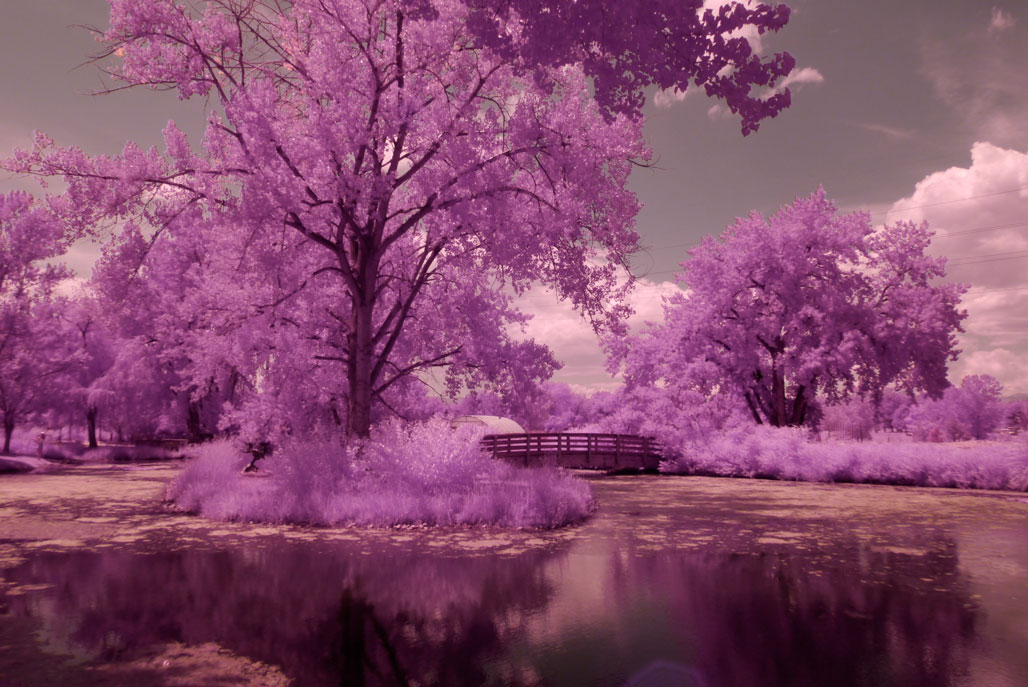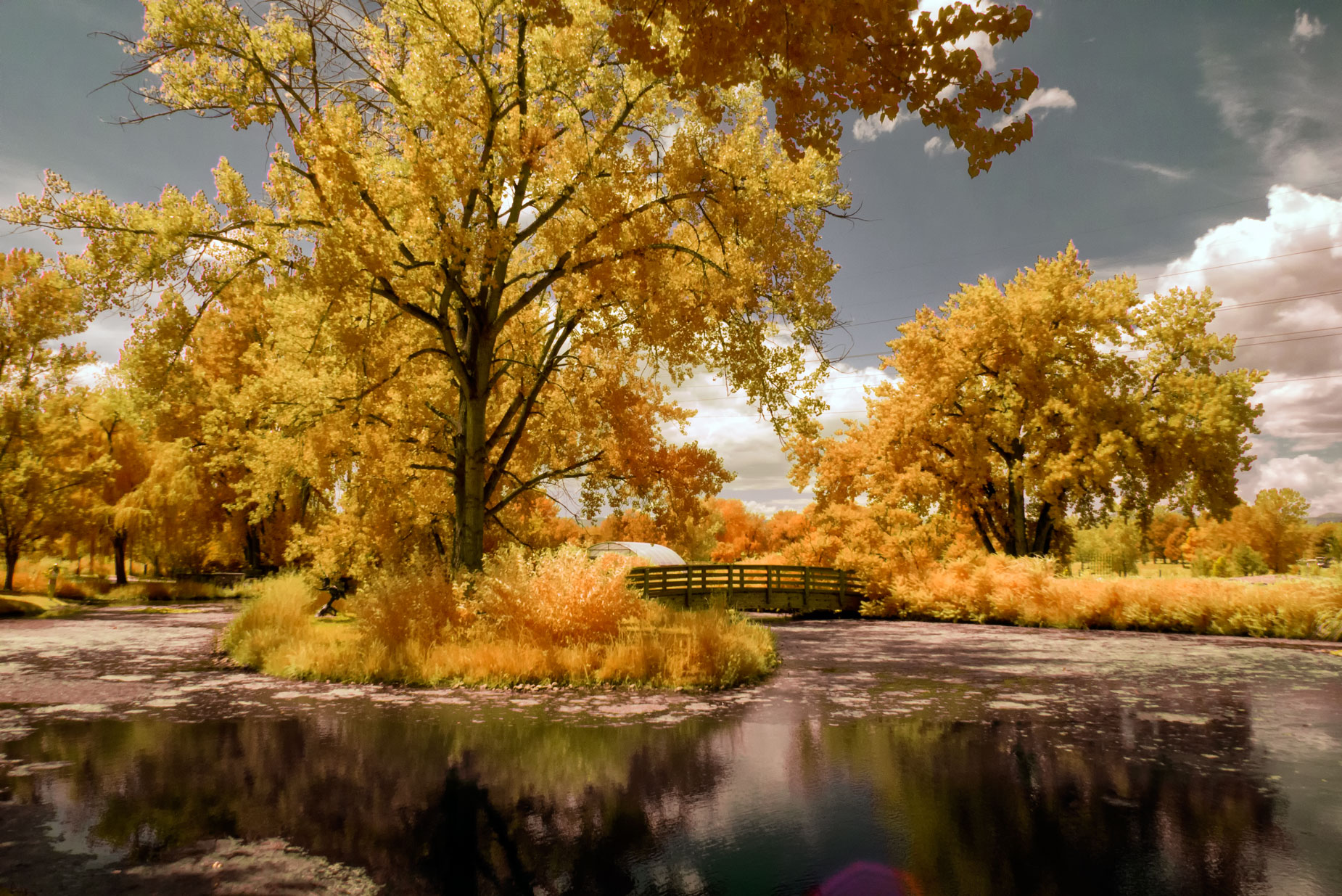Today’s Post by Joe Farace
 After I purchased a used Lumix GX1 from Roberts Camera and had it converted for infrared capture using Life Pixel’s Hyper Color filter*, I took the camera to the giant jacks and balls sculpture t Parker CO’s library to make some photos and immediately began to doubt my choice of cameras.
After I purchased a used Lumix GX1 from Roberts Camera and had it converted for infrared capture using Life Pixel’s Hyper Color filter*, I took the camera to the giant jacks and balls sculpture t Parker CO’s library to make some photos and immediately began to doubt my choice of cameras.
For starters, The glare on the GX1’s fixed screen was so bad that I found it difficult to shoot any composition that I tried. As far as color variations, LifePixel suggests using your-in camera’s white balance settings (“even Kelvin”) to capture a variety of tones in your images. Bouncing in an out of the White Balance menu turned out to be a pain in the patootie.
It turned out that both problems were easily solved: First, I borrowed the DMW-LVF2 tilting viewfinder that was attached to my (unmodified) black-body GX1. I slipped it onto the IR converted GX1’s hot shoe and was set to go. If you don’t own an LVF2, I’ve seen them available on eBay starting around $150, which I think is too expensive. Maybe when “my ships comes in,” I’ll buy a second one or maybe not.
 Second, making it convenient ti change white balance was easier. The GX1, like many mirrorless cameras, has Custom Settings on its Mode dial —C1 and C2—allowing each one to be customized. I found there were a few White Balance settings that produced dramatically different color and set up the C1 and C2 modes accordingly. Switching white balance modes was now just a dial spin, no menu diving required.
Second, making it convenient ti change white balance was easier. The GX1, like many mirrorless cameras, has Custom Settings on its Mode dial —C1 and C2—allowing each one to be customized. I found there were a few White Balance settings that produced dramatically different color and set up the C1 and C2 modes accordingly. Switching white balance modes was now just a dial spin, no menu diving required.
How I Made this shot: The above image was made during my PhotoWalk in Hudson Gardens last year with my pal Barry Staver. It was made using the Panasonic Lumix GX1 that I had converted by Life Pixel with their Hyper Color filter. The lens used was a Lumix G Vario 12-32mm f/3.5-5.6 (at 12mm) with an exposure of 1/400 sec at f/16 and ISO 400.
You can see what the unprocessed RAW file looks like at left. The RAW file was processed using some of the techniques covered in my post, How important is white balance in infrared photography? before applying an optional Photoshop action (Hyper Color to Super Color) that Life Pixel sometimes offers with conversions, at least they did when I had my GX1 converted. For similar but different results, you could also use the techniques I describe in my post How to Produce the Blue Sky Infrared Technique.

One of the most important lessons you can learn about shooting IR images is to forget everything you know about lighting, especially the best time of day to capture images. To give foliage that infrared glow you need to shoot at a time of day when there’s more sun on the scene rather than less. This puts your prime shooting times around mid-day! These are the worst times to make conventional color images but are the “golden hours” for infrared. If you need a rule of thumb, use one of Farace’s Laws: The best time of day to shoot infrared is when it’s the worst time of day to shoot normal images.
I feel like I’ve just begun to unlock this infrared conversion’s potential. Look for more explorations—including portraits—using the Hyper Color infrared filter as I get more experience with it.
*Life Pixel does not give a nanometer rating for the Hyper Color filter as it does for it’s other filters such as their Standard IR filter which is a 720nm filter that’s equivalent to Hoya R72 Filter/ Kodak Wratten 89b Filter
 I’ve found that Life Pixel does a great job with IR conversions and they have done most of the conversions for my Canon DSLRs and all of my Panasonic Lumix G-series cameras. This is not a paid or sponsored endorsement, just my experience.
I’ve found that Life Pixel does a great job with IR conversions and they have done most of the conversions for my Canon DSLRs and all of my Panasonic Lumix G-series cameras. This is not a paid or sponsored endorsement, just my experience.
My book, The Complete Guide to Digital Infrared Photography is available from Amazon with new copies available for $55 and used copies starting around nine bucks as I write this. Creative Digital Monochrome Effects has a chapter on IR photography and is available from Amazon with new copies available for $5.95 and used copies starting at a little more than four bucks.